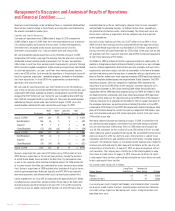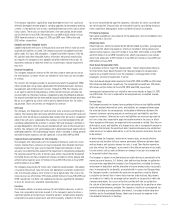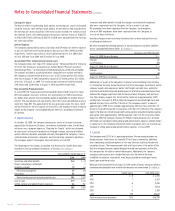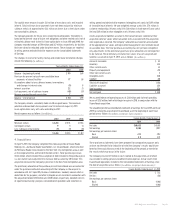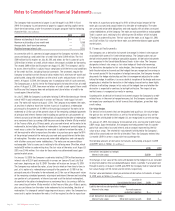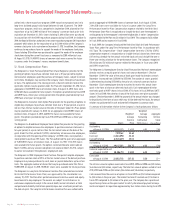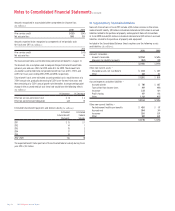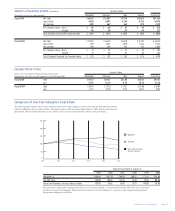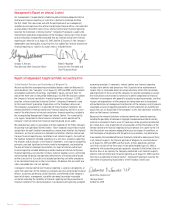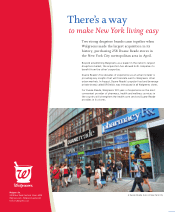Walgreens 2010 Annual Report Download - page 34
Download and view the complete annual report
Please find page 34 of the 2010 Walgreens annual report below. You can navigate through the pages in the report by either clicking on the pages listed below, or by using the keyword search tool below to find specific information within the annual report.
Notes to Consolidated Financial Statements (continued)
Generally, changes in estimates of expected future cash flows would have a similar
effect on the estimated fair value of the reporting unit. That is, a 1% change in esti-
mated future cash flows would decrease the estimated fair value of the reporting
unit by approximately 1%. The estimated long-term rate of net sales growth can
have a significant impact on the estimated future cash flows, and therefore, the fair
value of each reporting unit. For the two reporting units whose fair values exceeded
carrying values by less than 10%, a 1% decrease in the long-term net sales growth
rate would have resulted in the reporting units failing the first step of the goodwill
impairment test. Of the other key assumptions that impact the estimated fair values,
most reporting units have the greatest sensitivity to changes in the estimated
discount rate. A 1.0 percentage point increase in estimated discount rates for the
two reporting units whose fair value exceeded carrying value by less than 10%
would also have resulted in the reporting units failing step one. The Company
believes that its estimates of future cash flows and discount rates are reasonable,
but future changes in the underlying assumptions could differ due to the inherent
uncertainty in making such estimates.
Changes in the carrying amount of goodwill consist of the following activity
(In millions):
2010 2009
Net book value — September 1
Goodwill $ 1,473 $ 1,450
Accumulated impairment losses (12) (12)
Total 1,461 1,438
Acquisitions 442 23
Impairment charges (16) —
Net book value — August 31 $ 1,887 $ 1,461
The carrying amount and accumulated amortization of intangible assets consists
of the following (In millions):
2010 2009
Gross Intangible Assets
Purchased prescription files $ 749 $ 578
Tenancy rights 377 69
Purchasing and payer contracts 280 266
Trade name 44 26
Other amortizable intangible assets 103 62
Total gross intangible assets 1,553 1,001
Accumulated amortization
Purchased prescription files (293) (206)
Tenancy rights (38) (19)
Purchasing and payer contracts (68) (46)
Trade name (3) (11)
Other amortizable intangibles (37) (22)
Total accumulated amortization (439) (304)
Total intangible assets, net $ 1,114 $ 697
Amortization expense for intangible assets was $182 million in fiscal 2010, $148 million
in fiscal 2009 and $107 million in fiscal 2008. The weighted-average amortization
period for purchased prescription files was six years for fiscal 2010 and fiscal 2009.
The weighted-average amortization period for purchasing and payer contracts
was 13 years for fiscal 2010 and fiscal 2009. The weighted-average amortization
period for trade names was five years for fiscal 2010 and three years for fiscal
2009. Trade names include $6 million of indefinite life assets. The weighted-average
amortization period for other intangible assets was 10 years for fiscal 2010 and
10 years for fiscal 2009.
The aggregate purchase price of all business and intangible asset acquisitions,
excluding Duane Reade, was $221 million in fiscal 2010. These acquisitions added
$34 million to goodwill and $156 million to intangible assets, primarily prescription
files. The remaining fair value relates to immaterial amounts of tangible assets, less
liabilities assumed. Operating results of the businesses acquired have been included
in the Consolidated Statements of Earnings from their respective acquisition dates
forward. Pro forma results of the Company, assuming all of the acquisitions had
occurred at the beginning of each period presented, would not be materially different
from the results reported.
5. Goodwill and Other Intangible Assets
Goodwill and other indefinite-lived intangible assets are not amortized, but are
evaluated for impairment annually during the fourth quarter, or more frequently if
an event occurs or circumstances change that would more likely than not reduce
the fair value of a reporting unit below its carrying value. As part of the Company’s
impairment analysis for each reporting unit, the Company engaged a third party
appraisal firm to assist in the determination of estimated fair value for each unit.
This determination included estimating the fair value using both the income and
market approaches. The income approach requires management to estimate a number
of factors for each reporting unit, including projected future operating results,
economic projections, anticipated future cash flows and discount rates. The market
approach estimates fair value using comparable marketplace fair value data from
within a comparable industry grouping.
The determination of the fair value of the reporting units and the allocation of that
value to individual assets and liabilities within those reporting units requires the
Company to make significant estimates and assumptions. These estimates and
assumptions primarily include, but are not limited to: the selection of appropriate
peer group companies; control premiums appropriate for acquisitions in the indus-
tries in which the Company competes; the discount rate; terminal growth rates; and
forecasts of revenue, operating income, depreciation and amortization and capital
expenditures. The allocation requires several analyses to determine fair value of
assets and liabilities including, among other things, purchased prescription files,
customer relationships and trade names. Although the Company believes its esti-
mates of fair value are reasonable, actual financial results could differ from those
estimates due to the inherent uncertainty involved in making such estimates.
Changes in assumptions concerning future financial results or other underlying
assumptions could have a significant impact on either the fair value of the reporting
units, the amount of the goodwill impairment charge, or both. The Company also
compared the sum of the estimated fair values of its reporting units to the total
value as implied by the market value of its equity and debt securities. This comparison
indicated that, in total, its assumptions and estimates were reasonable. However,
future declines in the overall market value of the Company’s equity and debt
securities may indicate that the fair value of one or more reporting units has
declined below its carrying value.
One measure of the sensitivity of the amount of goodwill impairment charges to
key assumptions is the amount by which each reporting unit “passed” (fair value
exceeds the carrying amount) or “failed” (the carrying amount exceeds fair value)
the first step of the goodwill impairment test. For the reporting units that passed
step one, fair value exceeded the carrying amount by 6% to more than 700%. The
fair values for two reporting units each exceeded their carrying amounts by less
than 10%. Goodwill allocated to these reporting units was $173 million, at May 31,
2010. For each of these reporting units, relatively small changes in the Company’s
key assumptions may have resulted in the recognition of significant goodwill
impairment charges. The Company’s Long Term Care Pharmacy’s goodwill was
impaired by $16 million as a result of the asset sale agreement with Omnicare,
which was signed on August 31, 2010.
Page 32 2010 Walgreens Annual Report


